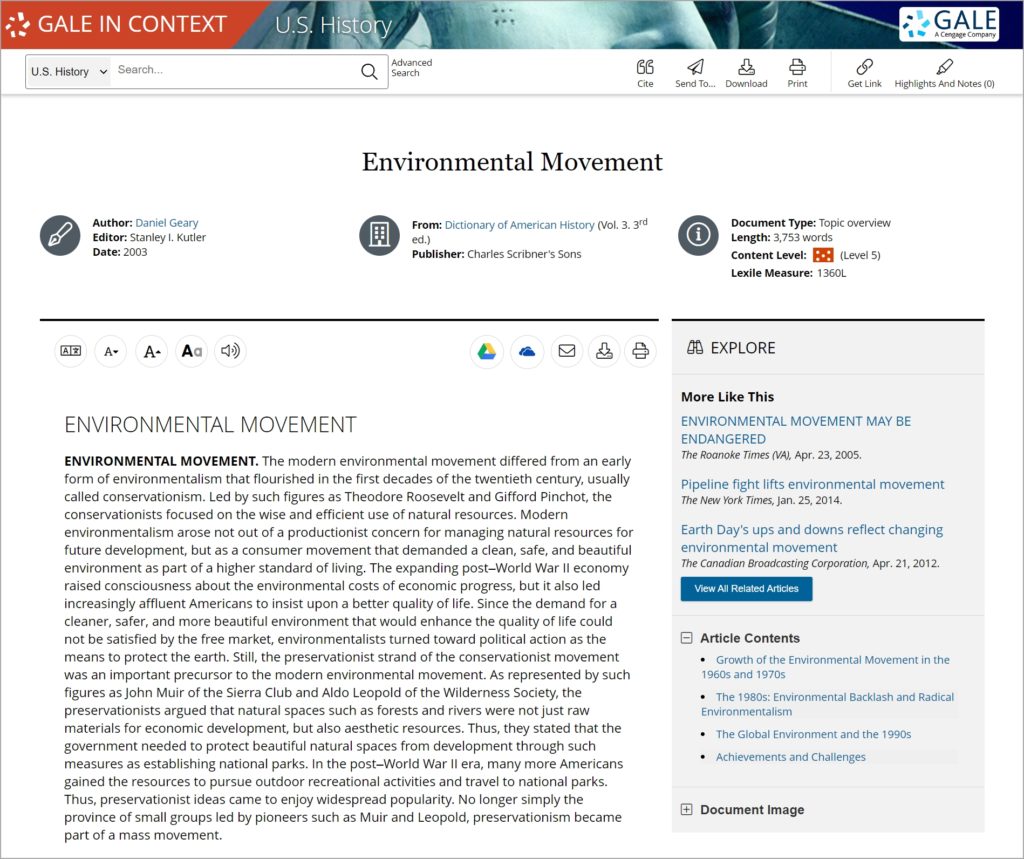| By J. Robert Parks |
The Clean Water Act, one of the most significant pieces of environmental legislation in the nation’s history, was enacted on October 18, 1972. Along with the establishment of the Environmental Protection Agency (EPA) in 1970, the Clean Water Act was critical in helping clean up polluted rivers, lakes, and other waterways and preventing future pollution. Gale In Context: U.S. History provides a number of resources for librarians and teachers to help students understand the early days of the environmental movement as well as the impact the Clean Water Act has had over the last 50 years.
Historian opinions differ on exactly when the environmental movement began. Some tie it to the conservation movement of the early twentieth century, led by John Muir and Aldo Leopold. Others see its beginnings in the 1960s and point to the impact that Rachel Carson’s book Silent Spring had when it was published in 1962. By raising an alarm about pesticides, Carson compelled Americans to think about how harmful industrial by-products, including pollution, were affecting the environment. This spurred a mass movement that culminated in the first Earth Day on April 22, 1970. It also pushed Congress to pass several key pieces of legislation, including the Clean Water Act.
The push for new water regulations was also spurred by two disasters that occurred in 1969. On one side of the country, near Santa Barbara, California, an oil well platform had a blowout that led to oil contaminating California beaches. On the other side of the country was an even more vivid disaster: the bursting into flames of the Cuyahoga River near Cleveland, Ohio. That was caused by toxic contamination and was a powerful example of what could happen if water pollution was left unchecked.
The Clean Water Act of 1972 wasn’t the first act Congress passed to control water pollution. One had been passed in 1899, another in 1948, and another in 1960, but the act of 1972 completely rewrote the rules for water use and pollution. It was enacted “to restore and maintain the chemical, physical, and biological integrity of the Nation’s waters.” This act differed from previous legislation in that it regulated the sources of pollution rather than relying on the water quality standards established by individual states. It also allowed the EPA to control how wetland areas were used. Furthermore, with the power of the EPA behind it, environmental regulation now had a more clear-cut enforcement mechanism and a central regulator.
The EPA was established by an executive order of Republican President Richard Nixon. However, Nixon did veto the Clean Water Act, citing the need to cut spending. His veto was overridden by a large majority in both the House and Senate, with Republicans joining Democrats.
Congress passed amendments to the Clean Water Act in both 1977 and 1987. The 1987 legislation was significant in that it imposed regulations about toxic pollutants and storm water runoff and created protections for national estuaries, the Chesapeake Bay, and the Great Lakes. It also increased civil and criminal penalties for violations, but it gave states more flexibility in meeting the requirements.
Although the Clean Water Act is overwhelmingly popular with the American public, corporations have often chafed at its regulations. Energy companies have balked when the EPA has exercised its authority to block permits for coal and natural gas mining due to the potential contamination of streams and lakes, and lawsuits have been filed over numerous EPA proposals. The Supreme Court has ruled in more than two dozen cases involving the Clean Water Act, often over the EPA’s authority and what should happen when it clashes with the authority of states. The battle over regulations has continued during the Joe Biden administration, as the EPA has looked to reverse rules made during the Donald Trump administration and has tried to reassert the stipulations of the Clean Water Act under a Supreme Court that includes the decision-making power of three Trump appointees.
About the Author
J. Robert Parks is a former professor and frequent contributor to Gale InContext: U.S. History and Gale In Context: World History who enjoys thinking about how our understanding of history affects and reflects contemporary culture.



